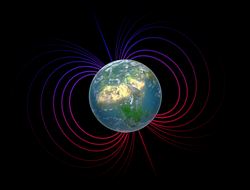Modelling the dynamic magnetosphere
Until recently, the global energy transfer was assessed by correlation analyses of solar wind parameters and indices of magnetospheric activity. But, with rapidly increasing computational power, global modelling of the magnetospheric magnetic field has become feasible. The least computationally demanding magnetohydrodynamic (MHD) approach has significantly evolved with a number of codes now available for space physics research. Unfortunately, many large-scale magnetospheric processes cannot be reproduced in MHD models. Within the QUESPACE (Quantifying energy circulation in space plasma) project, researchers sought to implement kinetic physics into global models. To this end, they used Vlasov's equation to model the evolution of the ion distribution directly while treating electrons as a fluid. The main benefit of such a hybrid-Vlasov approach is the ability to produce ion distribution functions comparable to those measured in situ by spacecraft. Due to the computational complexity, however, only local hybrid-Vlasov simulations had been possible before QUESPACE. Researchers developed numerical methods to solve the Vlasov equation and utilised the most advanced methods in parallelisation to allow description of the Earth's space environment at ion scales. Vlasiator(opens in new window) is a newly developed global kinetic-scale space environment simulation. Using the Partnership for Advanced Computing in Europe (PRACE) Hermit supercomputer, QUESPACE performed the first global hybrid-Vlasov simulations. Vlasiator was able to reproduce key features of solar wind-magnetosphere interaction, such as wave-particle interaction processes at the ion foreshock. Importantly, ion distributions reproduced in the simulations were consistent with known single- and multi-spacecraft observations at the foreshock. In particular, Cluster satellites show compressional magnetosonic waves in agreement with the picture reproduced in the simulations. In contrast to spacecraft observations, Vlasiator models the entire magnetospheric cavity in a holistic manner where processes may be followed in space and time, providing a major step forward. QUESPACE work has defined new standards in space plasma physics simulations.







